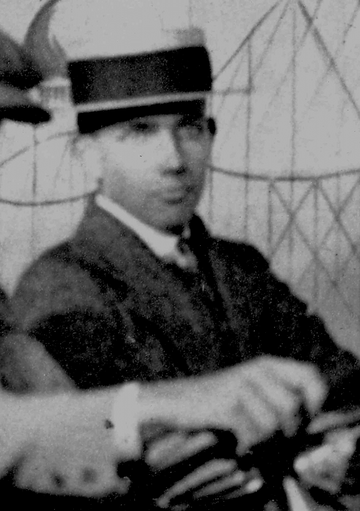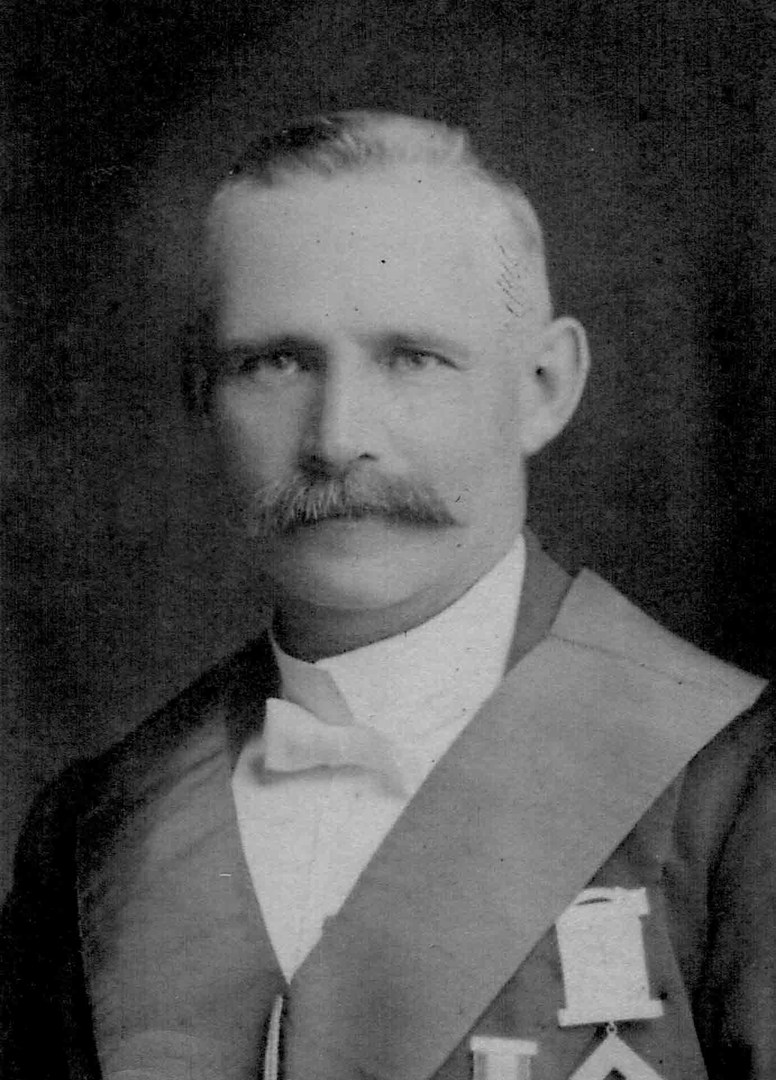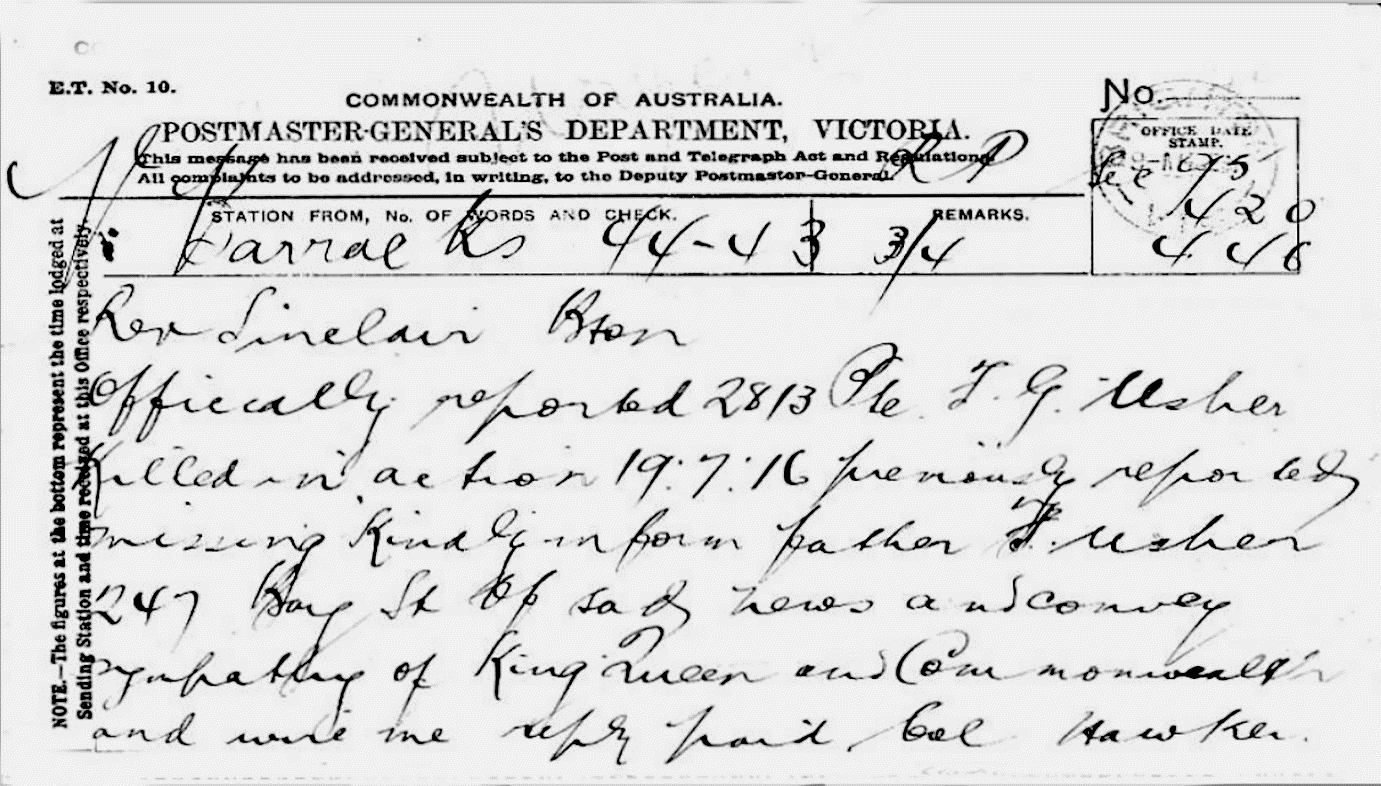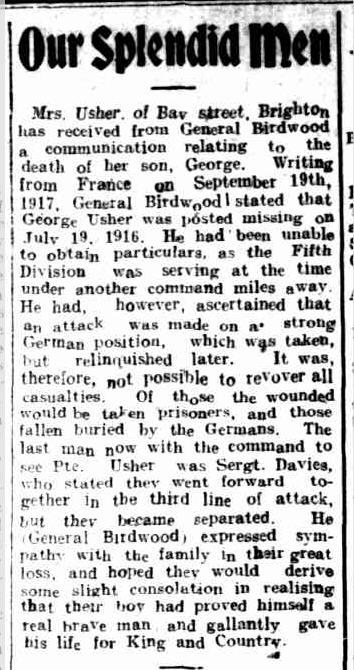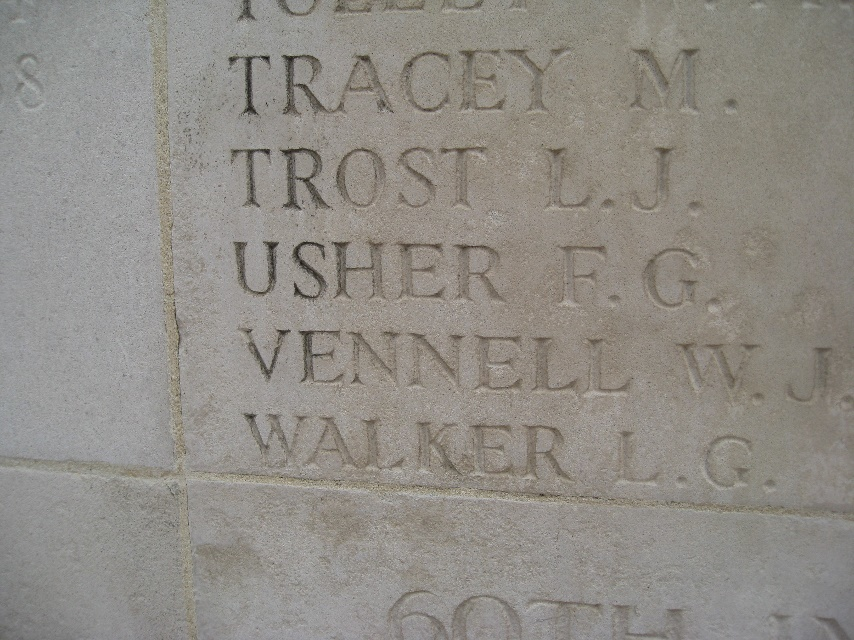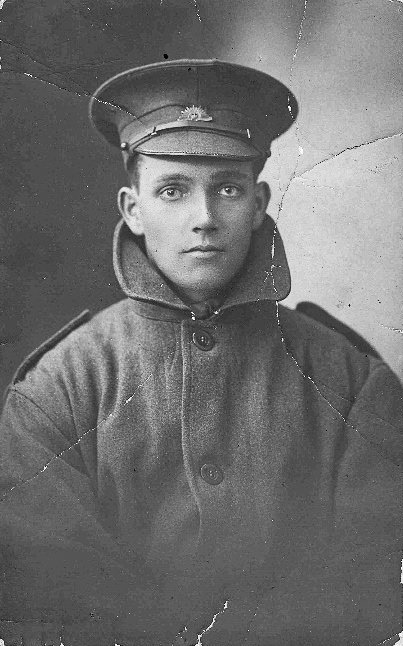Frederick George USHER
Eyes blue, Hair dark brown, Complexion sallow
Family correspondence - “I am this soldier’s Mother.”
With thanks to Pam Connan, great-niece of George Usher, for sharing his story.
From the day he sailed from Melbourne, George (as he was always known by family) kept in contact with regular letters to his mother, Mary. In turn, Mary replied keeping him informed of all the local news of family, friends, neighbours and local community happenings. She was a faithful correspondent, and it appears she never waited for a letter to arrive for her to reply. It was for her a way of feeling in touch.
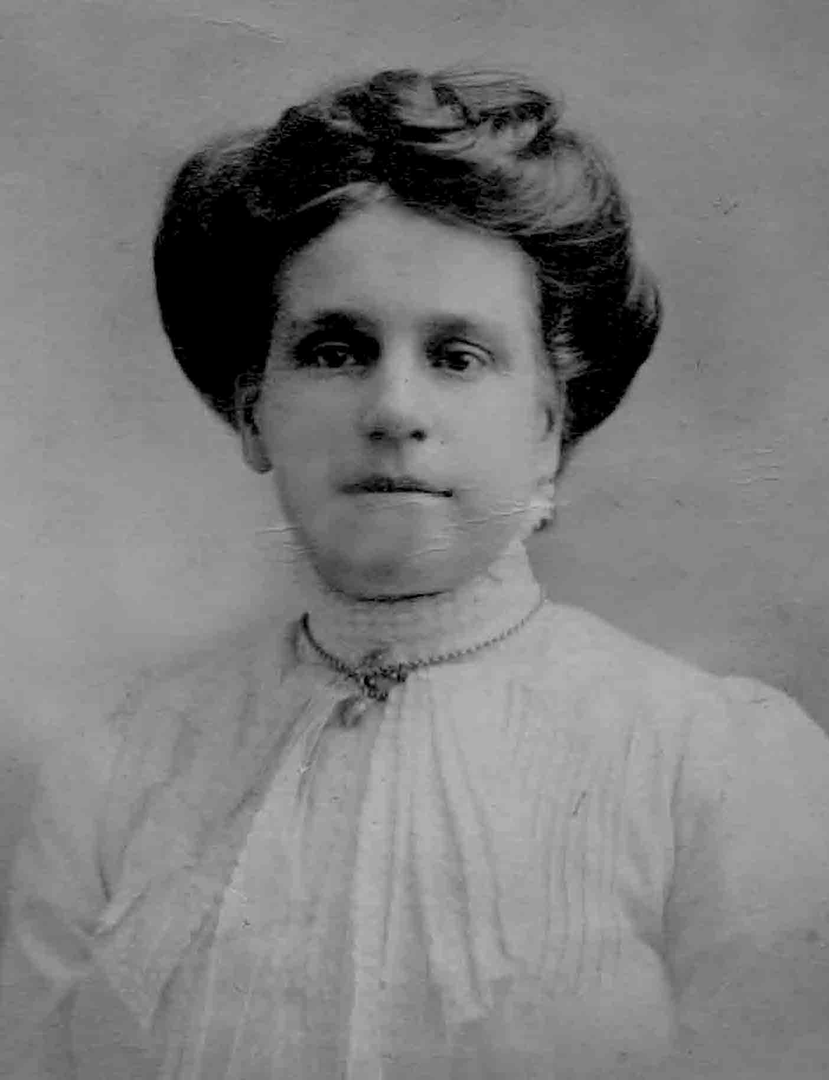
The family have treasured all the letters that George wrote to his mother and, quite remarkably, have all the letters that Mary wrote to George after he was declared missing, as the Army returned them all. It is with great sadness that family have read the letters and share the grief as she innocently wrote not knowing they would never be read.
The family were sent a telegram – still safely in the family’s possession - to say George was missing. This arrived on 2 September 1916. One cannot even begin to grasp the despair that must have been felt on receiving that news – a despair exacerbated by the length of time it took for information to reach the family. In a letter that Mary wrote to the Army in March 1917, she requested any information that could be forthcoming and concluded her letter saying simply, "I am this soldier's Mother." This sentence says so much and how desperately helpless she must have felt.
In April 1917, Mary received a letter saying that another soldier had sighted George and that he was in the UK recuperating from pneumonia. This sadly turned out to be incorrect as it related to another Private Usher in the same Battalion and not her son. False hope. One can only imagine the confusion, angst and grief that this gave the family.
A shoemaking family business
The Usher family established Usher's Shoe Store in Bay Street, Brighton and it remained in family hands after being handed down to George’s brother, Norman (Pam Connan’s grandfather). In a way, it was a fortunate thing, as much of the family’s history (including George’s correspondence) wasn't moved around but stayed in one place.
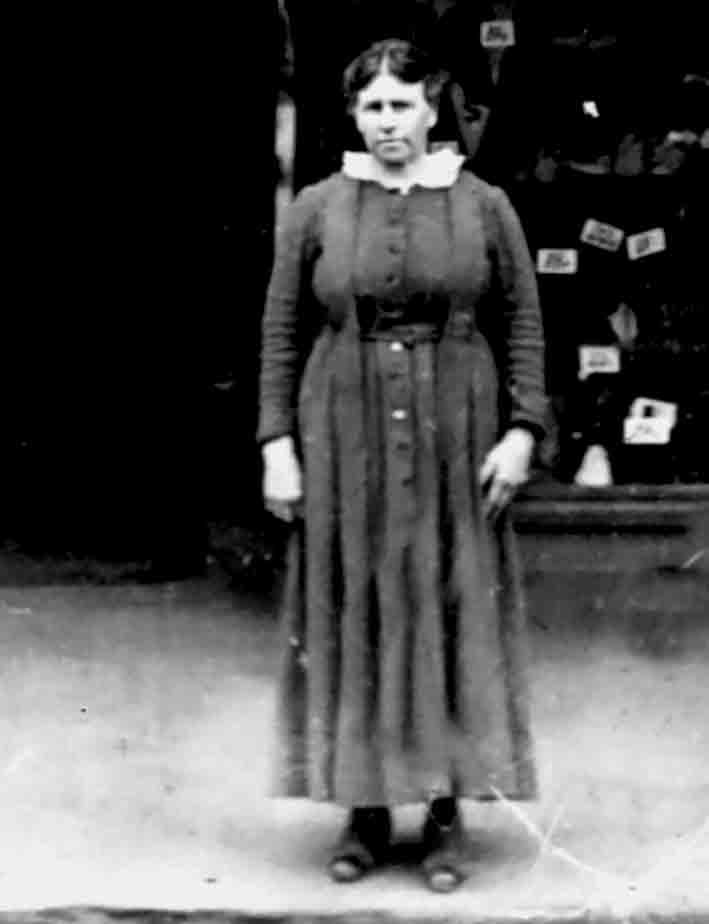
George was a shoemaker and salesman prior to enlisting having been apprenticed to prominent Melbourne boot manufacturers, Marshall & Co.. No doubt, if he had returned from the war, he would have been the natural choice as the eldest son to take over the business. As events transpired, George’s younger brother, Norman, a farmer, returned from the Mallee in 1920 to work and manage the shoe store which he did until retirement in 1955.
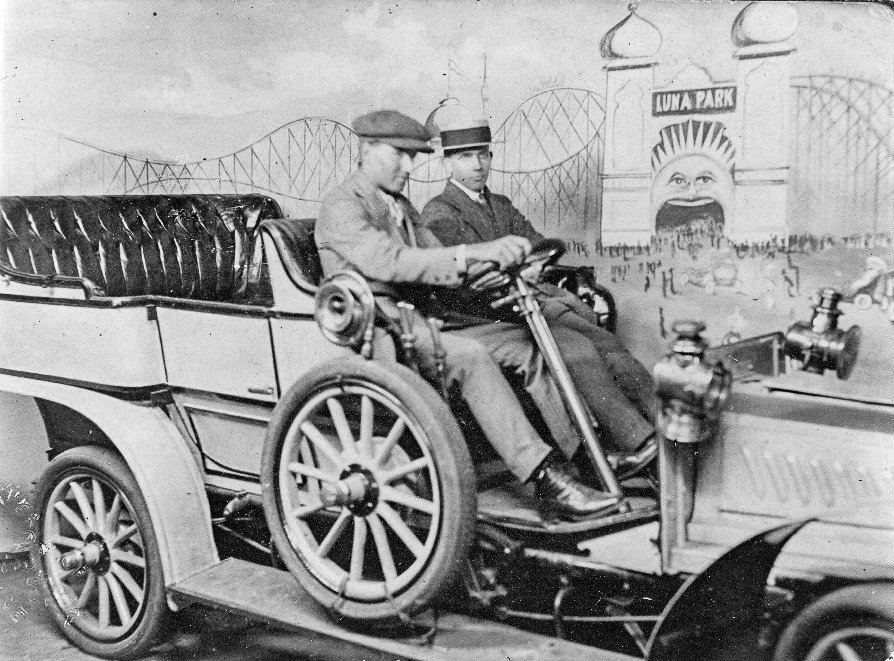
George Usher’s war - July 1915 – July 1916
Enlisting in July 1915, George undertook training with the 22nd Battalion at the Broadmeadows camp. They embarked from Melbourne on HMAT A38 Ulysses arriving in Egypt in late November. In early 1916, George was transferred as part of the post-Gallipoli re-organisation of the AIF, first to the 57th Battalion and then a few weeks later to the 59th Battalion.
George was hospitalised for a short while with high fevers but returned to serve with the 59th Battalion until they left Egypt for France in June. In his last letter home to his mother dated 2 July 1916, he described France as ‘the most beautiful country I have ever seen’. The following extracts tell part of his experience in France:
“The Frenchmen are very industrious people and speaking of those living out of Paris, everyone seems to have a small plot of ground and all under cultivation with potatoes, grape vines, fruit trees, wheat, oats and hay and other fodders, the crops are very good and must return a good thing to their owners. We notice that from the start of our journey that men on the farms are very few and what there are old and women doing the work for them, the bakers, and milk carts are nearly all driven by women, …………
…………We are close to the firing line, and I believe the enemy aeroplanes pass over this way occasionally, so if that is so we will have some excitement, while waiting our turn for the trenches………………….
………..The days here at present are of great length, being light in the morning at 4 o'clock and not getting dark until ten o'clock, we have an hour and a half twilight.
We had some great news this morning that the British and ANZAC troops had advanced over 2 to 4 miles on a fourteen mile front, all our boys are anxious to be in these moves, we are only 18 miles away from them, so can reach them very quickly if wanted.
We have been living on day rations while on the moving caper, they have been good, butter cheese biscuits, bully beef, our food now could not be better though the quantity is small, we don't always get what rations we are entitled to but as the quality is good we don't mind so much…………”
Less than a month after arrival, they were in the trenches and about to engage in their first major battle. According to the Australian War Memorial, “The battle of Fromelles was a disaster for the 59th. Attacking in the first wave, the 59th suffered heavy casualties at the hands of German machine-gunners, and its advance faltered far short of its objective.”
In the aftermath of the battle, George was reported as missing on 19 July 1916 with the family being notified by telegram on 2 September 1916, pictured below.
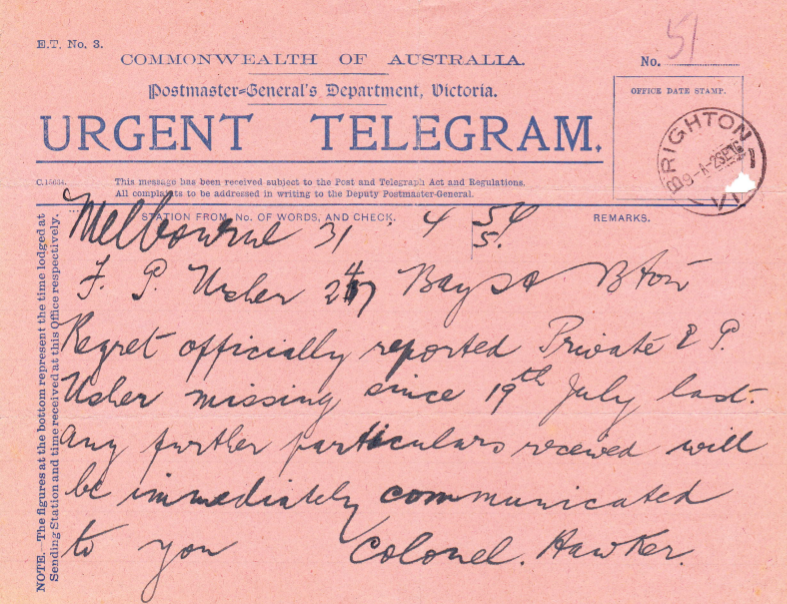
What happened to George?
A court of enquiry held in the field on 29 August 1917 pronounced George’s fate as 'Killed in Action, 19 July 1916' but no specific details were known. As his mother noted in a 1921 letter to the army:
‘…not one of his comrades who came out of that dreadful battle saw him fall.’
There is no definitive information about how George met his fate and initial enquiries were made more complicated by a mix-up with another Private Usher in the 59th Battalion – Private 2448 Gordon Rupert Usher. Reports by comrades that George had been wounded and was recovering in Etaples, France were incorrect, relating instead to the other Private Usher.
There was also an unconfirmed report from Lance Corporal 3093A George Horsey, 59th Battalion, about Private George Usher that:
“…I myself brought him in from ‘No Man’s Land’ on a stretcher, & he died before we got him to the dressing station. He was a very nice fellow…”
Horsey qualified his evidence however stating that he was:
“not quite certain that he may be the Usher you know. Don’t tell his mother till I find out further particulars because it will break her up…”
There is nothing further on file to confirm or contradict Horsey’s version of events but we do note as an aside that Lance Corporal Horsey was awarded a Military Medal for his work at Fromelles. He worked all night under trying conditions after he volunteered to go out to rescue wounded men under heavy shrapnel and machine gun fire on the night of 19/20 July 1916 and again on the night of 20/21 July. Horsey’s evidence also gives credence to a handwritten note on George’s AIF Personnel file (page 4) that George was “Presumed Buried in No Man's Land approx 5J90-43 to 5K0.25.1 Sheet Hazebrouck 5a”.
It seems that George’s family were never to know the particulars about his death, but his mother received a letter from General Birdwood advising that Sergeant Davies may have been the last to see George alive. Sergeant Davies advised that he went forward with George in the third line of attack but they became separated.
Nothing further is known and, to this day, George has no known grave. He is however commemorated at VC Corner Australian Cemetery and Memorial at Fromelles and on the Australian War Memorial Roll of Honour in Canberra.
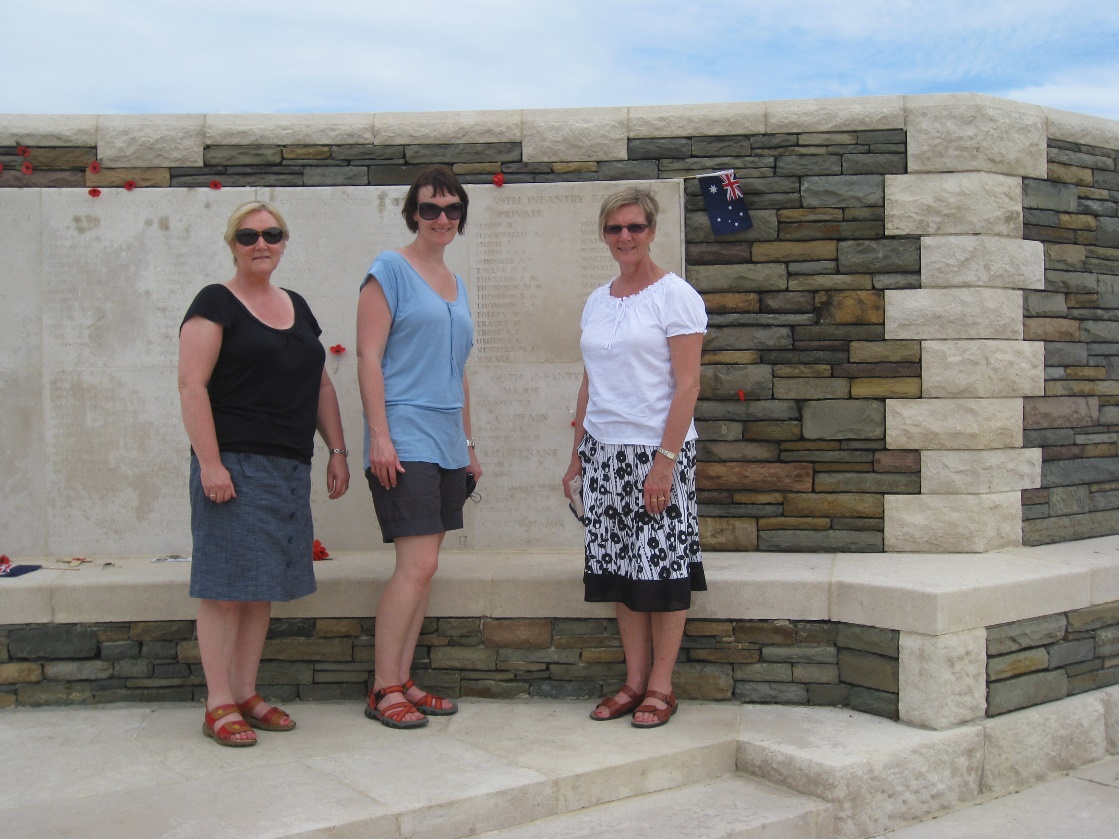
One boy in the 59th and the other in the 60th
So, while there was a great deal of correspondence and worry around George, his youngest brother, Reg, would also have been part of continuing deep concern, as he was severely wounded. Reg was a bank clerk who joined up on 18 August 1916 at age 19. At that time, the family would have known that George was in the trenches but would not yet have known that he was missing.
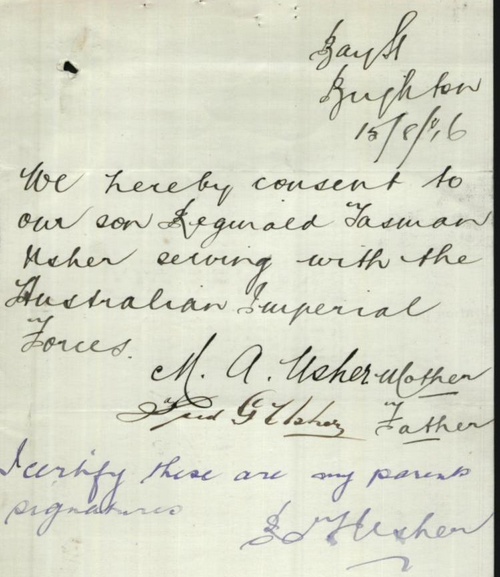
Reg was assigned to the 60th Battalion and left Australia on 2 October 1916. On arrival in England, Reg was promptly hospitalised for some weeks with the measles. After his recovery, Reg was posted to France in January 1917. He served on the Western Front until he was wounded on 25 September 1917 having been blown up by a shell on the Menin Road. He underwent some months of treatment in France and England for neurological and shell-shock symptoms arising from the head injury.
In March 1918, Reg was returned to Australia and then discharged as medically unfit. He did, however, re-enlist in World War 2 in the Citizens Military Forces (Service Number V159870).
Pam Connan – her connection to her great-uncle, George
“From an early age, I was aware that my mother had two uncles who went to the first world war. These gentlemen were my grandfather Norman's brothers, Reg and George. Uncle Reg returned from the war but oddly I know less about him than I do about George. It was always a heavy family sadness that George did not return.
My mother, Dorothy, always had a keen interest in the Battle of Fromelles and any media attention she would grasp onto it, cutting out news clips from newspapers. It was always in the hope that one day she would find out more information about her lost Uncle George. When the graves of the unknown soldiers were found near Pheasant Wood, her interest intensified. It was then that my curiosity grew with her desire to find her uncle.
Along with my sister and two daughters, I was privileged to be part of the opening ceremony of the cemetery in Fromelles and it was a momentous occasion for me to represent my family and to speak at the opening. It is wonderful that many of the soldiers have been named and are now at rest in their rightful place.
Private Frederick George Usher, unfortunately, is not one of them and he is still not identified.”
Proud to honour George’s memory – the 2010 opening ceremony
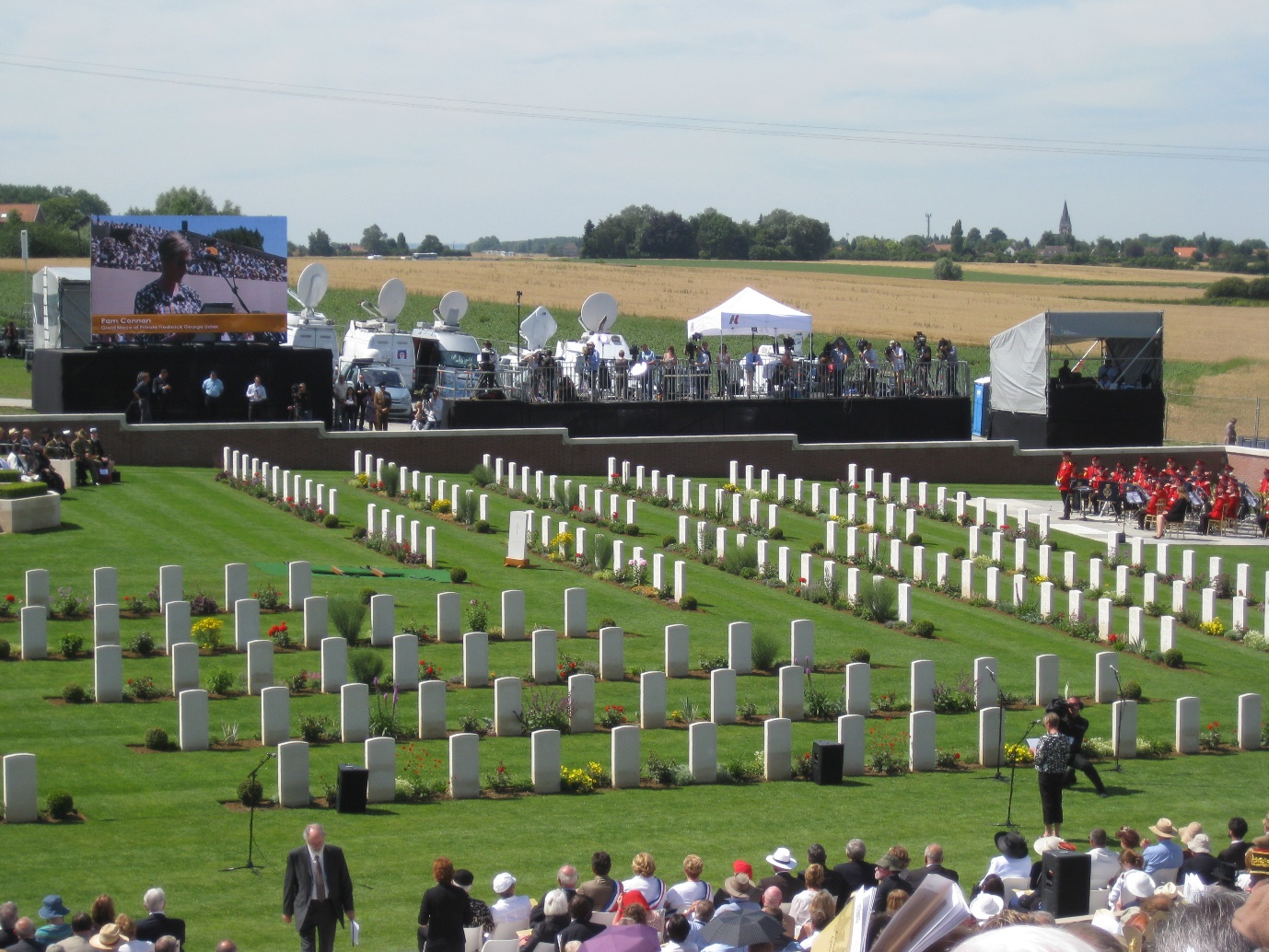
“I still - after more than a decade - get a bubble of excitement about being part of the opening ceremony for the new Pheasant Wood Cemetery on 19 July 2010.
The government organising committee had sent requests for anyone who had any memorabilia, letters or information to submit it to them for use at the ceremony. I scanned and sent off a couple of letters - the last one that George wrote and also the telegram sent to say he was missing – and thought nothing more of it.
About two weeks before the ceremony, there was a message on my answering machine asking me for permission to use the letters at the service. Next morning, I phoned and said it was fine, and I asked why they needed permission as I thought submitting them would have been sufficient. The reply was that they needed to ask as I was not going to be there to read them myself. I was the only one whose submissions were chosen but was not going to attend! I was surprised but asked – maybe a bit cheekily - if I could be a reader. The immediate reply was- “Of course you can!”
I spoke to my parents and they were beyond excited and very kindly offered to pay our airfares. There was no holding us back ...we were off!
That day was a frantic time, speaking to family, organising time off work, flights, hotels, etc. This was no mean feat for my sister who had never travelled overseas before but luckily had a passport, and my daughter had to apply for leave as well. My other daughter lives in London, so we joined her there for a brief stopover before heading to Lille on the Eurostar joining the royal and other dignitaries headed for the ceremony. They were in the front carriage - we were further back. The travel arrangements, by train and bus, were made through the UK Army and it was amazing - so brilliantly organised and executed.
I was so proud to be representing my family for our missing Uncle George.”

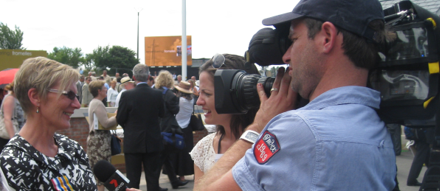
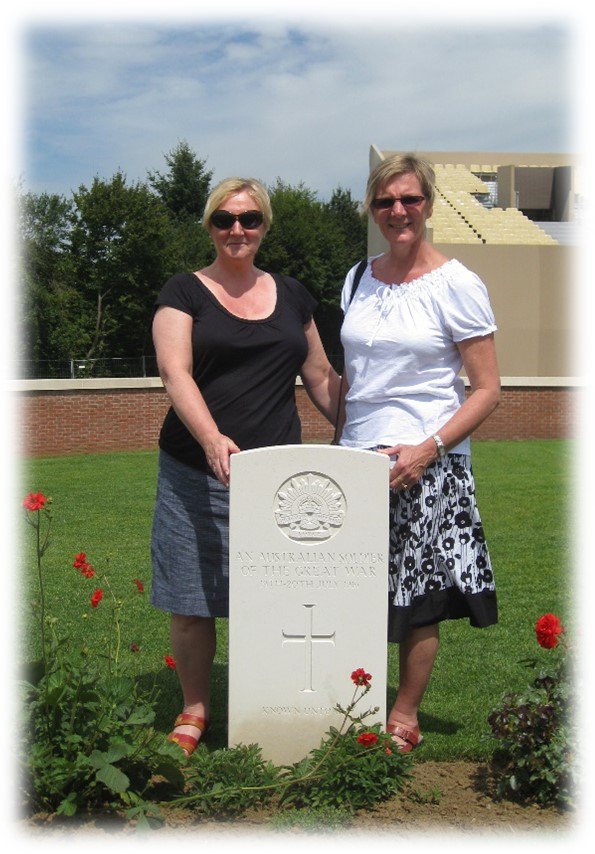
In memory of Frederick George Usher as yet not found.
May he one day be given a respectful resting place.
Both Y and mt DNA is still being sought from family
| Soldier | Frederick George USHER (known as George) 1889-1916, St Kilda, Vic. |
| Parents Frederick George USHER 1863-1941, Clunes, Victoria | |||
| Mary Ann MILLER (known as Polly) 1864-1953, St Kilda, Victoria |
| Grandparents | All 4 grandparents migrated to Australia & died in Victoria. | ||
| Paternal | Jabez USHER 1824-1916, Trowbridge, Wiltshire, England and Emma Jane EDWARDS 1829-1906, Somerset, England | ||
| Maternal | Jacob MILLER 1838-1917, Bavaria, Germany and Catherine Sarah Ann STREETING 1838-96, Peckham Surrey, England |
Links to Official Records
Seeking DNA Donors

Contacts
(Contact: carla@fromelles.info or geoffrey@fromelles.info).
(Contact: army.uwc@defence.gov.au or phone 1800 019 090).
Donations
If you are able, please contribute to the upkeep of this resource.
(Contact: bill@fromelles.info ).
